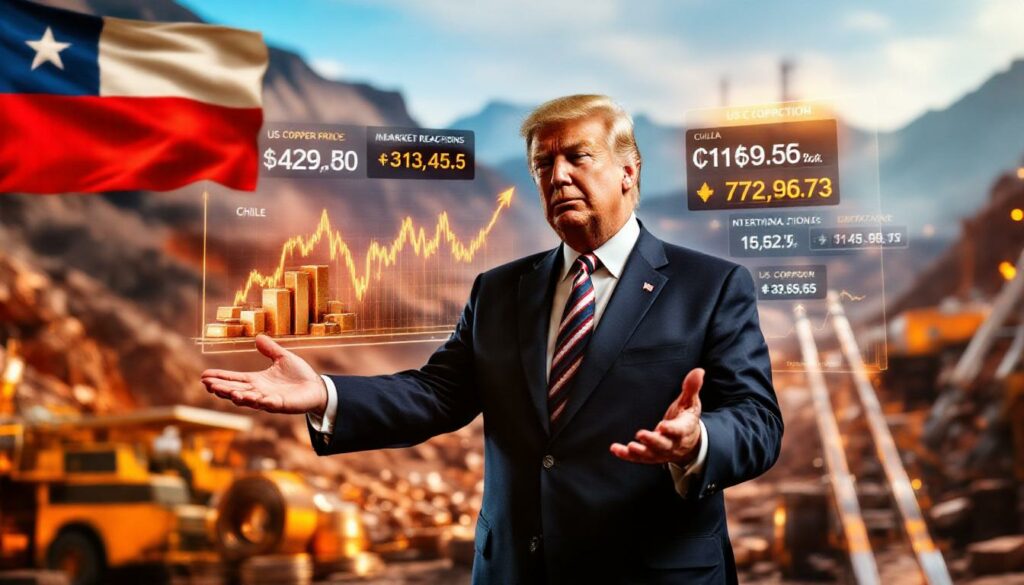Understanding Trump's 50% Copper Tariff Announcement
On July 10, 2025, the global metals market experienced a seismic shift when US President Donald Trump announced a 50% tariff on copper imports to the United States, effective August 1, 2025. This aggressive trade measure represents one of the most significant policy interventions targeting critical minerals in recent years.
The tariff aims to bolster domestic copper production, which the administration deems essential for national security, particularly in defense applications, electronics manufacturing, and the automotive industry. Unlike previous trade measures, this tariff includes no phased implementation approach, suggesting an immediate and comprehensive application to refined copper entering US markets.
What Exactly Is the New Tariff Policy?
The policy targets copper imports with a blanket 50% duty, representing a dramatic escalation in America's resource nationalism stance. According to market analysts at MINING.com, this move signals "a fundamental shift in how the US approaches critical mineral supply chains," positioning copper alongside other strategically important materials like rare earth elements and lithium.
The tariff's scope primarily covers refined copper, though specifics regarding semi-finished products remain under clarification. Industry experts note this distinction will be crucial, as the tariff's effectiveness hinges on precisely which copper products fall under its purview.
"This tariff represents the culmination of a years-long push to reshore critical mineral supply chains, but the implementation details will determine whether it achieves its stated goals or simply raises costs for American manufacturers," notes a recent MINING.com analysis.
Key Timeline and Implementation Details
The announcement on July 10, 2025, caught many industry participants by surprise, despite growing protectionist rhetoric from the administration. With implementation scheduled for August 1, 2025, companies have a narrow three-week window to adjust supply chains and make strategic decisions.
Unlike previous trade measures that included country-specific exemptions or phased implementation timelines, this Trump tariff breakdown appears to apply universally to all copper imports regardless of origin. This approach has triggered diplomatic concerns, particularly from longstanding trading partners like Chile, which supplies approximately 28% of US copper imports according to the US Geological Survey.
Market participants must now navigate a complex transition period, with shipments already en route facing potential tariff exposure upon arrival after the August 1 deadline.
What Happened to Copper Prices After the Announcement?
The market reaction to Trump's 50% copper tariff announcement was immediate and dramatic, reflecting the critical importance of copper in global industrial supply chains.
Immediate Market Reaction
US Comex copper futures surged to an all-time high following the announcement, with prices briefly touching $6.20 per pound before settling at $5.5445 per pound on July 11, 2025—representing a 1.50% pullback from the peak but still maintaining historically elevated levels.
The unprecedented price volatility sent shockwaves through copper-dependent industries, with trading volumes reaching three times their normal levels as market participants scrambled to secure supplies ahead of the tariff implementation.
A pronounced price differential between US and international markets began forming almost immediately, creating arbitrage opportunities for traders and logistical challenges for multinational corporations with operations spanning multiple jurisdictions.
Price Divergence Between US and Global Markets
Analysts predict this announcement will create a two-tier global pricing structure, with substantially higher prices inside the US and potentially depressed prices in international markets as suppliers redirect shipments away from America to avoid the tariff.
According to commodity research firm CRU Group, "US domestic prices could rise by as much as 30-40% above international benchmarks once the tariff takes effect, potentially making US manufacturing less competitive in global markets."
This divergence creates complex strategic decisions for copper suppliers:
- Maintain US market share: Accept tariff costs and reduced margins
- Redirect to alternative markets: Potentially face oversupply and price pressure elsewhere
- Establish US operations: Long-term solution but requires significant investment
- Negotiate exemptions: Pursue legal/political channels for relief
For US consumers of copper, this bifurcated market presents immediate challenges in securing supply at competitive prices, with implications rippling through construction, electronics, and renewable energy sectors.
How Will Major Copper Producers Respond?
The global copper production landscape faces significant disruption from this policy shift, with major producing nations and mining corporations forced to recalibrate strategies.
Chile's Reaction as the World's Top Producer
Chile, which supplies nearly 28% of US copper imports according to the US Geological Survey, faces perhaps the most significant economic impact from the tariff. The Chilean government has demanded clarity on the tariff implementation, with President Gabriel Boric publicly stating he had not received official communication about the measure.
"This unilateral action threatens decades of stable trade relations between our countries," President Boric noted in a press statement, indicating that Chile is exploring various response options, including potential WTO challenges.
Industry experts anticipate a significant redirection of Chilean copper exports to alternative markets, particularly China and Europe, as producers seek to avoid the punitive US tariff. Cochilco, Chile's copper commission, estimates that approximately 40% of the country's copper exports currently go to the United States—a flow that could dramatically shift in coming months.
This redirection, however, creates its own challenges, as increased supply to non-US markets could depress prices in those regions, creating a complex balancing act for Chilean producers.
Mining Companies' Strategic Adjustments
Major mining corporations are quickly formulating strategic responses to this dramatic market shift. Companies with significant US copper investment stand to benefit from higher domestic prices, while those reliant on exporting to the US face difficult decisions.
Barrick Mining Corporation, one of the world's largest gold and copper producers, maintains a long-term bullish outlook despite the short-term volatility. CEO Mark Bristow expressed confidence in copper's fundamentals, stating: "Copper's long-term trajectory remains unchanged despite US tariff policy decisions. We are seeing a shortage in supply and growing demand, particularly with data centers, cleaner energy, and emerging markets' industrialization."
Barrick is backing this confidence with substantial investment, committing $2 billion to double output at its Lumwana copper mine in Zambia from 120,000 to 240,000 metric tons annually by 2028, while extending the mine's operational life to 2057.
Other significant adjustments emerging across the industry include:
- Accelerated exploration: Companies fast-tracking US-based copper projects
- Supply chain restructuring: Developing new processing routes to minimize tariff exposure
- Strategic stockpiling: Building inventories ahead of the August 1 implementation
- Alternative market development: Strengthening ties with non-US buyers
The industry response reflects both short-term tactical adjustments and longer-term strategic repositioning in a fundamentally altered market landscape.
What Are the Long-Term Market Implications?
Beyond immediate price volatility and supply chain disruptions, Trump's copper tariff has significant implications for the structural balance of global copper markets over the coming decade.
Supply and Demand Dynamics
Industry consensus suggests global copper demand will continue to outpace supply regardless of tariff policies. As Barrick CEO Mark Bristow noted, "Everyone is in agreement that copper demand is outgrowing the supply side."
This supply-demand imbalance is driven by several powerful trends:
-
Data center expansion: The global digital infrastructure boom requires significant copper for power systems, cooling infrastructure, and connectivity. According to the International Energy Agency, data centers could drive a 15% increase in copper demand by 2030.
-
Clean energy transition: Solar arrays, wind turbines, and grid infrastructure all require substantial copper inputs. Electric vehicles use approximately three times more copper than conventional vehicles.
-
Emerging market industrialization: As developing economies build out infrastructure and manufacturing capacity, copper intensity increases significantly.
Supply constraints remain significant, with limited major new projects coming online. The S&P Global consultancy projects a potential 9.9 million metric ton copper deficit by 2035 if current production trends continue.
Investment Trends in Copper Production
While the tariff may accelerate investment in US copper projects, the global picture shows a more measured approach to new development. As Barrick's Bristow observed, "Most of the copper industry today is only looking at marginal expansion."
Barrick's $2 billion investment to double output at its Lumwana copper mine in Zambia demonstrates exceptional confidence in copper price prediction trends. The project aims to increase production from 120,000 to 240,000 metric tons annually by 2028 while extending the mine's operational life to 2057.
This substantial commitment contrasts with the broader industry approach, where capital discipline and brownfield expansions dominate over greenfield developments. According to Fitch's BMI analysis, global copper mine output is projected to rise at a 2.9% annual rate over the next decade, growing from 23.8 million tonnes in 2025 to 30.9 million tonnes in 2034.
For US domestic production specifically, the tariff creates economic incentives that could make previously marginal projects viable, though permitting and development timelines remain significant hurdles. According to SNL Metals & Mining, the US could potentially increase domestic production by less than 5% in the short term, with more substantial growth requiring years of development.
How Might Global Trade Patterns Shift?
The imposition of a 50% tariff on copper imports will inevitably reshape global trade flows, creating both challenges and opportunities across the copper value chain.
Potential Redirection of Copper Flows
Major copper exporters to the US, particularly Chile, Peru, and Canada, will likely redirect substantial shipments to alternative markets, primarily China, Europe, and emerging economies in Asia. This redirection creates complex ripple effects throughout the global market.
According to MINING.com analysis, "Redirection to China and Europe could trigger oversupply in non-US markets," potentially leading to a copper price collapse in those regions while US prices surge. This geographical price disparity creates incentives for creative tariff avoidance strategies.
Industry observers note several potential market responses:
- Third-country processing: Routing copper through countries with US free trade agreements
- Product reclassification: Modifying products to fall outside tariff categories
- Substitution: Increased use of aluminum or other alternatives where technically feasible
- New trading relationships: Development of direct producer-consumer agreements outside traditional exchanges
A particularly notable development is the emerging Mercuria-Zambia partnership creating a new Africa-Europe copper corridor, illustrating how quickly trade patterns can evolve in response to policy shifts.
Impact on International Trade Relationships
The tariff introduces significant friction into international trade relationships, with potential retaliatory measures from affected countries. Trade tensions could extend beyond copper to encompass broader US‑China trade impacts as producing nations seek leverage.
Historical precedent suggests retaliation often targets politically sensitive US exports, particularly agricultural products. As MINING.com analysts note, "Retaliation could target US agricultural exports," creating broader economic ripples beyond the metals sector.
The tariff also impacts multilateral trade frameworks, potentially undermining WTO disciplines and encouraging the development of new trade agreements that exclude or minimize US participation. This fragmentation of global trade governance presents both geopolitical and economic challenges.
Diplomatic relationships face strain as resource nationalism increases globally. The tariff reinforces a trend toward treating minerals as strategic assets rather than purely commercial commodities, a perspective that fundamentally alters traditional trade negotiations.
What Does This Mean for Copper Mining Investment?
The tariff creates a dramatically altered investment landscape for copper mining projects, with significant implications for capital allocation, project timelines, and investor sentiment.
Investment Outlook for Copper Projects
US domestic copper projects have seen valuations surge approximately 12% following the tariff announcement, according to Bloomberg analysis, as their economic viability improves under the new pricing regime. Projects previously considered marginal may now attract investment interest, particularly those with advanced permitting status.
Companies with established US copper reserves stand to benefit disproportionately, as they can leverage existing infrastructure and permitting to accelerate production increases. However, the tariff's long-term durability remains a significant uncertainty factor for investors contemplating major capital commitments.
International projects face a more complex calculus, weighing reduced US market access against potential growth in alternative markets. Projects with geographical or logistical advantages serving non-US markets may see enhanced investor interest as trade flows reorganize.
The overall investment picture suggests:
- Accelerated timelines: US projects already in development will likely see expedited schedules
- Valuation premiums: US copper assets commanding higher multiples than comparable international projects
- Financing advantages: Easier capital access for US-focused developers
- Strategic acquisitions: Potential consolidation as majors seek US exposure
However, investors must weigh these advantages against substantial political risk, as future administrations could reverse or modify the tariff policy.
Production Forecasts
According to Fitch's BMI analysis, global copper mine output is projected to rise by 2.9% annually over the next decade, growing from 23.8 million tonnes in 2025 to 30.9 million tonnes by 2034. The tariff may accelerate US production within this global trend, though significant increases face substantial hurdles.
US domestic production growth faces several constraints despite improved economics:
- Permitting timelines: New copper mines typically require 7-10 years from discovery to production
- Environmental review: Rigorous assessment processes for new developments
- Infrastructure limitations: Smelting and refining capacity constraints
- Technical expertise: Skilled labour shortages in the mining sector
These factors suggest that while the tariff may improve project economics, the supply response will be gradual rather than immediate. According to SNL Metals & Mining, short-term US production increases are likely limited to less than 5% of current capacity, primarily through optimization of existing operations.
How Will End Users of Copper Be Affected?
The tariff creates significant challenges for industries reliant on copper inputs, potentially reshaping manufacturing economics and consumer markets.
Impact on Manufacturing and Technology Sectors
US manufacturers using copper components face substantially higher input costs, potentially creating competitive disadvantages relative to international producers. According to Deloitte analysis, this could translate to 10-15% price increases for US builders and automakers as they absorb higher material costs.
The electronics sector, particularly semiconductor manufacturing and data center infrastructure, faces acute margin pressure given copper's critical role in these applications. MINING.com analysis notes that "Electronics and EV sectors face acute margin pressure" from the tariff, potentially accelerating research into material substitution where technically feasible.
This cost pressure creates several strategic imperatives for copper-intensive industries:
- Supply chain restructuring: Establishing manufacturing in locations with lower copper costs
- Product redesign: Minimising copper content where possible
- Material substitution: Accelerating research into alternatives like aluminium
- Pricing strategies: Determining how much cost can be passed to consumers
For US manufacturers exporting finished goods, the tariff creates a particularly challenging situation, as they must compete internationally while bearing higher input costs than their foreign competitors.
Consumer Price Implications
The increased costs for copper inputs will likely be passed on to consumers in various forms, particularly in copper-intensive products and infrastructure.
Construction materials face particular exposure, with electrical wiring, plumbing fixtures, and HVAC systems all containing significant copper content. According to industry estimates, this could add 1-2% to overall construction costs for residential properties.
Consumer electronics may see modest price increases, though the copper content represents a smaller proportion of total product value in these applications. Nevertheless, the cumulative effect across multiple product categories creates broader inflationary pressure.
Particularly notable impacts include:
- Housing affordability: Increased costs for new construction and renovations
- Infrastructure projects: Higher costs for power grid improvements and public works
- Automotive pricing: Additional materials costs for both conventional and electric vehicles
- Regional variations: More significant impact in areas with high construction activity
The Copper Development Association notes that US scrap supply could potentially fill approximately 25% of the supply deficit, potentially moderating some price impacts through increased recycling efficiency.
Want to Stay Ahead of Major Mining Discoveries?
Discovery Alert's proprietary Discovery IQ model delivers real-time notifications on significant ASX mineral discoveries, empowering subscribers to identify actionable opportunities before the broader market. Explore why major mineral discoveries can lead to substantial returns by visiting the Discovery Alert discoveries page and begin your 30-day free trial today.




